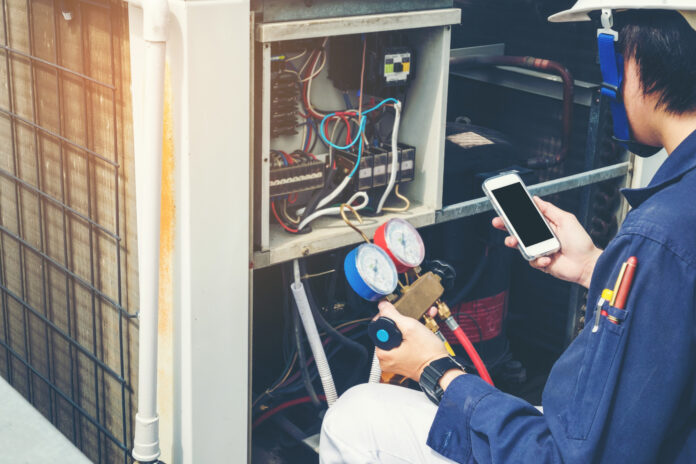The average cost of installing an HVAC unit in your home ranges between $5000 and $12000. Systems with ductwork cost more to install but guarantee longevity.
Homeowners should direct more energy into looking for the best contractors. Not all contractors are fit to install HVAC systems. The inexperienced ones may end up making mistakes during the installation process.
The last thing you want is to start the re-installing process with another company. It will drain you financially and mentally.
It would be better if you knew what to look for before hiring contractors. Keep reading as we discuss seven common HVAC installation mistakes and how to avoid them.
1. Hiring Inexperienced Contactors
Choosing the right HVAC company can be a lengthy process. Thus, it’s common for homeowners to settle for the first one they can get. Hiring an HVAC contractor without performing your due diligence is a risky move.
Most homeowners go by word of mouth. Yet, all contractors will tell you they are best at replacing HVAC systems.
Without much experience, contractors are more likely to make common HVAC installation mistakes. For instance, taking expensive budget cuts is common among sketchy contractors. The last thing any homeowner wants is the contractors using your HVAC system as a test kit.
To avoid this crucial mistake, ensure you inquire about their work experience. Besides, checking online reviews or asking around will help you identify experienced contractors.
2. Using Wrong HVAC Dimensions
Using the wrong dimensions is among the most common HVAC issues that homeowners face. It’s an issue that causes long-term damage. This means that you’ll end up replacing your outdoor HVAC unit.
Besides, some homeowners think that bigger dimensions translate to better performances. Instead of approaching the selection process like that, take time to study your home needs. The HVAC contractor should take these dimensions, too, before installing a residential HVAC system.
Only shortlist HVAC companies near me that are willing to conduct the pre-visit. This way, they can confidently begin the HVAC installation process that the unit is the right fit for your home needs.
3. Lack of Breathing Room for the HVAC System
Common HVAC issues arise from poor installation and lack of proper maintenance. You should install your HVAC unit where there is plenty of room to operate.
This makes it easier for the air to freely flows in and out of the system. So ensure you don’t place the system in a cramped space. If it’s an outdoor HVAC unit, ensure the surrounding is free from bushy vegetation.
Proximity to foliage puts the system at risk of sucking the leaves and the branches. To avoid this issue, ensure that the HVAC system is in an open space.
Alternatively, build a special cage for the residential HVAC system. This will also protect the unit from harsh weather conditions.
4. Replacing HVAC Systems in Parts
Most homeowners find it cheap to replace broken parts instead of installing a new system. Sure, it works for some time, but it can pose a significant danger to the entire system.
You may look for the cheapest spare parts, but they don’t match the quality of the original system. They lack longevity and block sufficient airflow.
There are two parts; the indoor and the outdoor HVAC unit. The whole residential HVAC system should operate as one. So, it becomes less efficient when a part doesn’t match with another.
The best way to avoid this issue is to contact the HVAC contractor. They can help you get the spare of the exact models or replace HVAC systems.
5. Poor Duct Design
The efficiency of a residential HVAC system lies in the duct design. Thus, it’s essential to pay extra attention to it. The duct system is responsible for distributing the hot or cool air throughout the room.
A leaking duct is one of the most common HVAC installation mistakes. To avoid it, you must understand the type of piping needed for your duct system.
Choose a reliable company to conduct leak tests on the duct after the HVAC installation. They will assess whether the duct parameters agree with the HVAC system. It pays to be extra keen on corners, ceilings, and diffusers.
6. Ignoring the Permits
Before you begin the HVAC installation process, it’s important to understand what the state laws say about such operations. There are clear guidelines in each state that outline how you should carry out each process.
As a regulation, HVAC contractors should have permits that prove they have undergone the necessary training.
To avoid any trouble with the law, ask to see the permits. Licenses prove that they have authorization from the government.
Besides, it helps to work with registered contractors. You can easily reach them if anything goes wrong with your residential HVAC system.
7. Running the HVAC Unit Continuously
If you let your HVAC system run all the time, you are inviting trouble. Turning it off every once in a while allows better functionality, especially when there is no one at home.
Besides, it will help you cut down on energy consumption. It only takes a few minutes to regulate the temperature of a room.
Leave your HVAC system running for as long as it’s needed. The run should depend on the size of the room and external temperatures. The good thing about this issue is that it’s easy to rectify.
However, you can’t do much to save an HVAC system that has been running continuously for a long time.
Common HVAC Installation Mistakes and How to Avoid Them
A residential HVAC system is a long-term investment. It promotes comfortable living by creating a conducive environment. The contractors should articulate the HVAC installation process with the utmost keenness.
Follow the above guide to avoid common HVAC installation mistakes. These costly mistakes will have you incurring re-installation expenses.
Take time choosing a reliable contractor to help you in your HVAC installation. If you enjoyed reading this piece, check out more articles.










